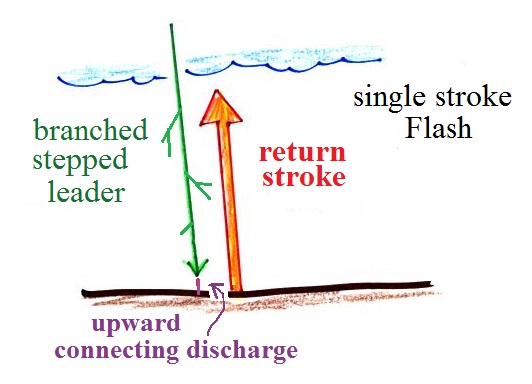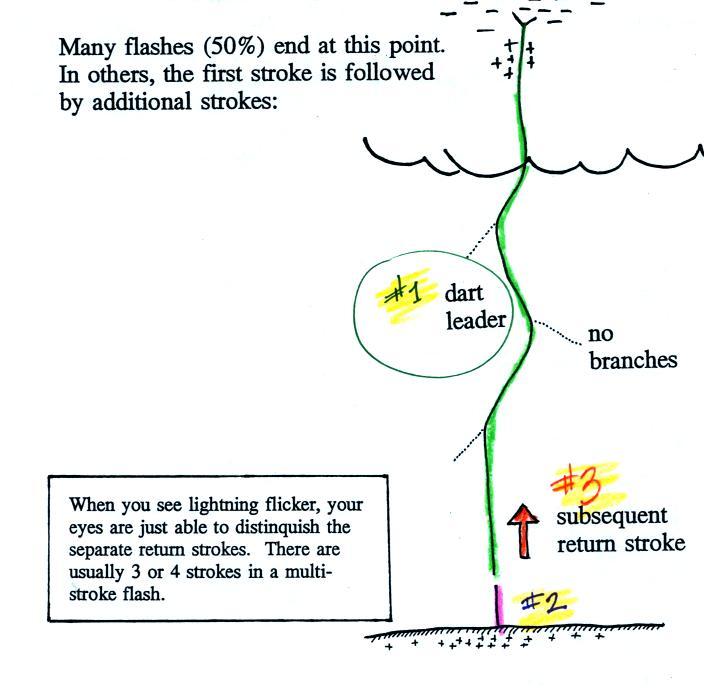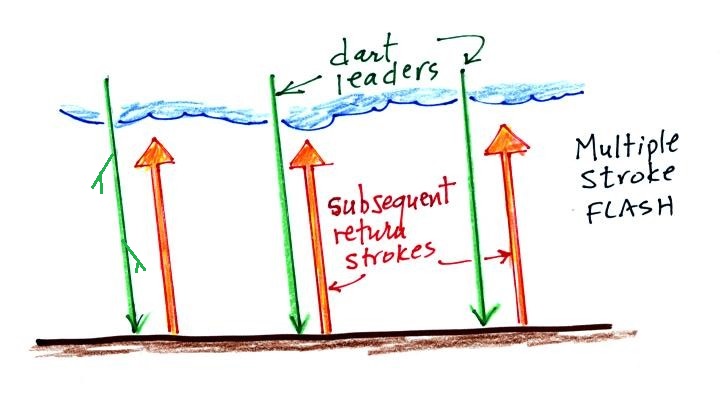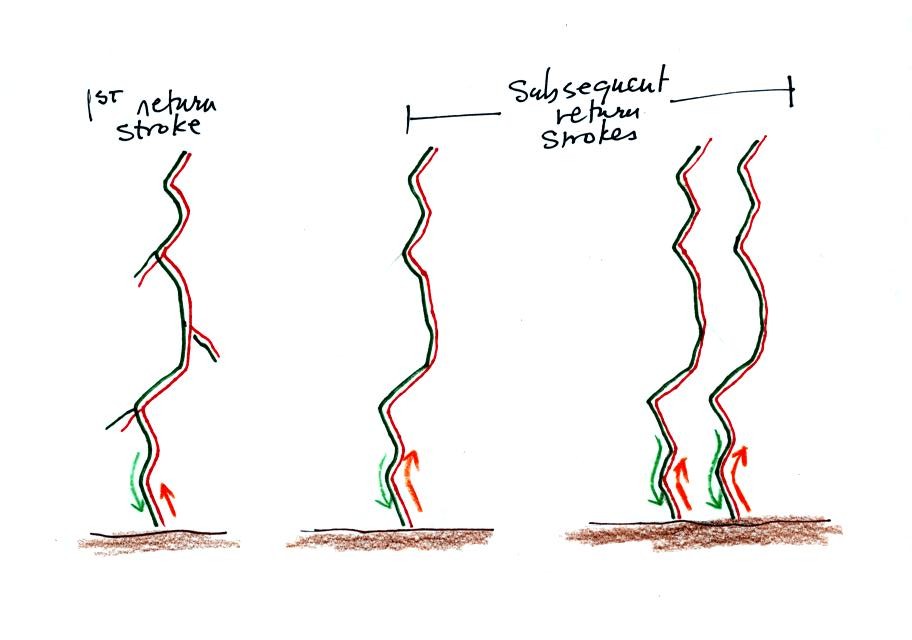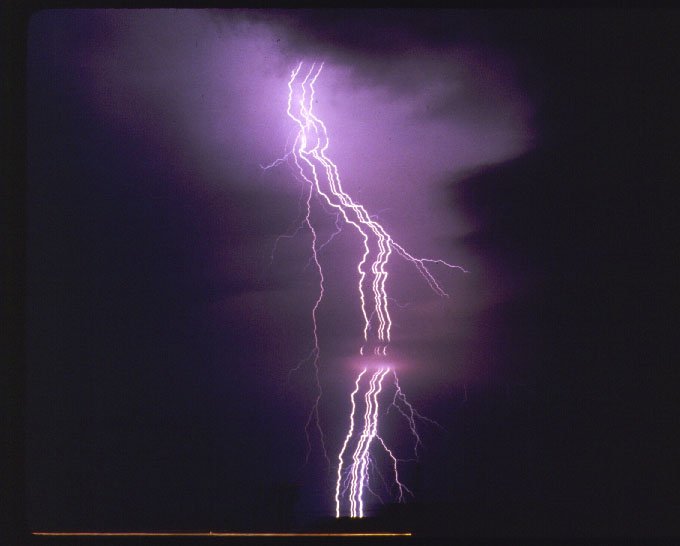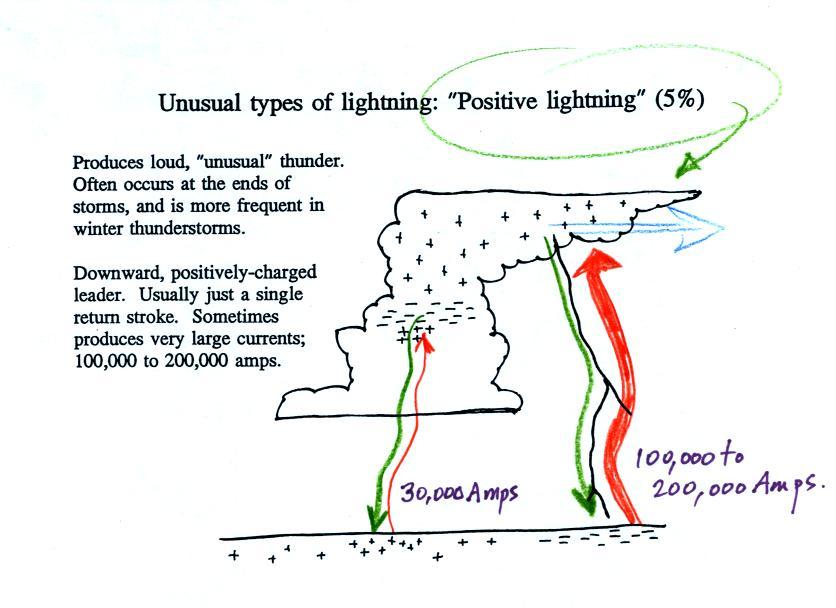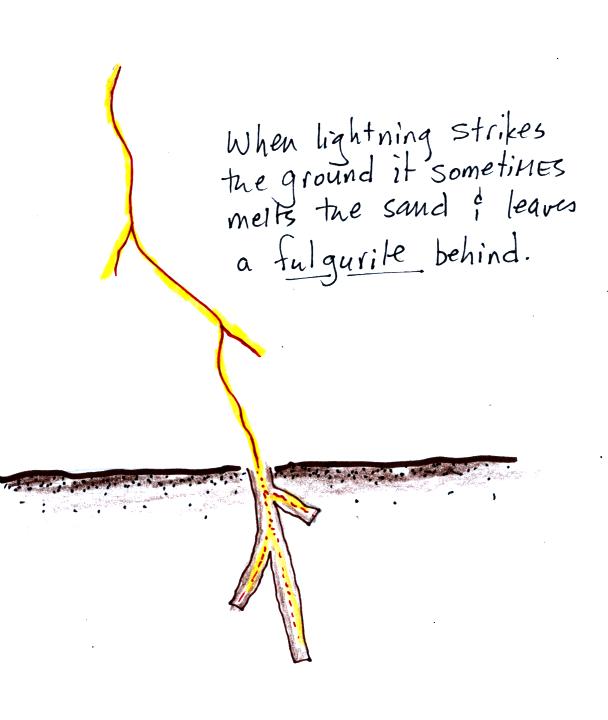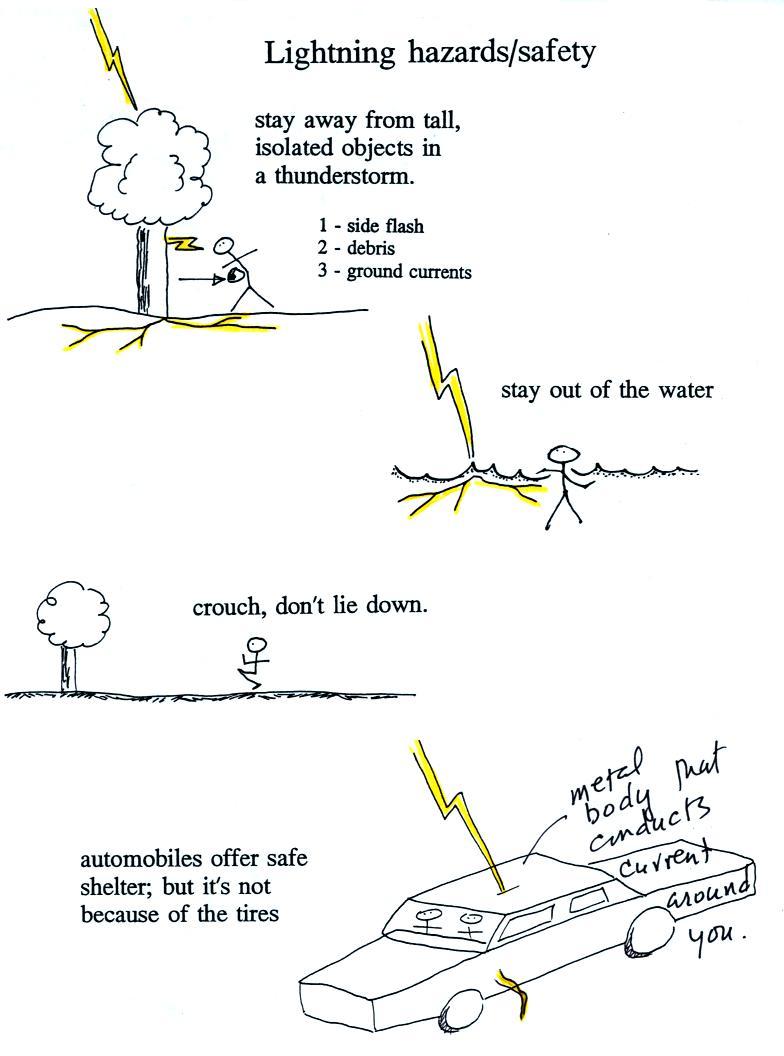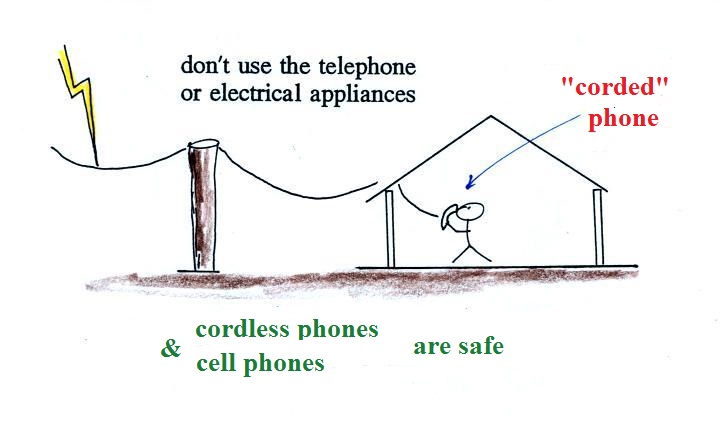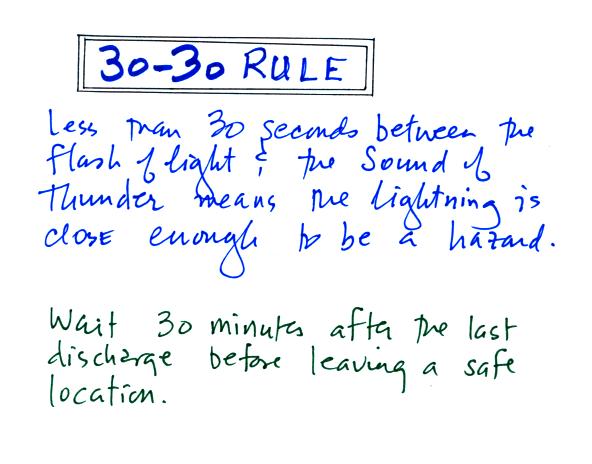Friday, Apr. 20, 2018
Blue Man Group "The Complex
Rock Tour" (18:30) or maybe an appearance on the NPR Tiny Desk
Concert (13:15)
Quick recap of the series of events that
comprise a negative cloud-to-ground lightning strike
5. Multiple strokes flashes - dart leaders and
subsequent return strokes
A downward dart leader travels
from the cloud to the ground. The dart leader doesn't step but
travels smoothly and follows the channel created by the stepped
leader (avoiding the branches). It is followed by a
slightly less powerful subsequent return stroke that travels
back up the channel to the cloud. This second stroke might
be followed by a third, a fourth, and so on. The
subsequent return stroke channel usually doesn't have branches.
Here's a stepped leader-upward
connecting discharge-return stroke animation
(you'll see the stepped leader, upward discharges, and the
first return stroke. Two additional subsequent
strokes are shown without the dart leader).
The sketch above and the photo below show a multiple stroke
flash consisting of 4 separate return strokes. There is enough
time between separate return strokes (around 1/20th to 1/10th of a
second) that your eye can separate the individual flashes of
light. Separate return strokes cause the flickering you
sometimes see when looking at lightning.
6. Positive (cloud-to-ground)
lightning
We've been looking at strikes that originate in the negative
charge center is a thunderstorm (discharge at left in figure
above). Occasionally a lightning stroke will
travel from the positive charge region in the top of the
thunderstorm cloud to ground (shown at right in the figure
above). These types of strikes are more common at the ends
of storms and in winter storms. This is
probably because the top part of the cloud gets pushed sideways
away from the middle and bottom portions of the cloud.
Positive strokes are very powerful. They sometimes produce
an unusually loud and long lasting clap of thunder.
7. Upward lightning
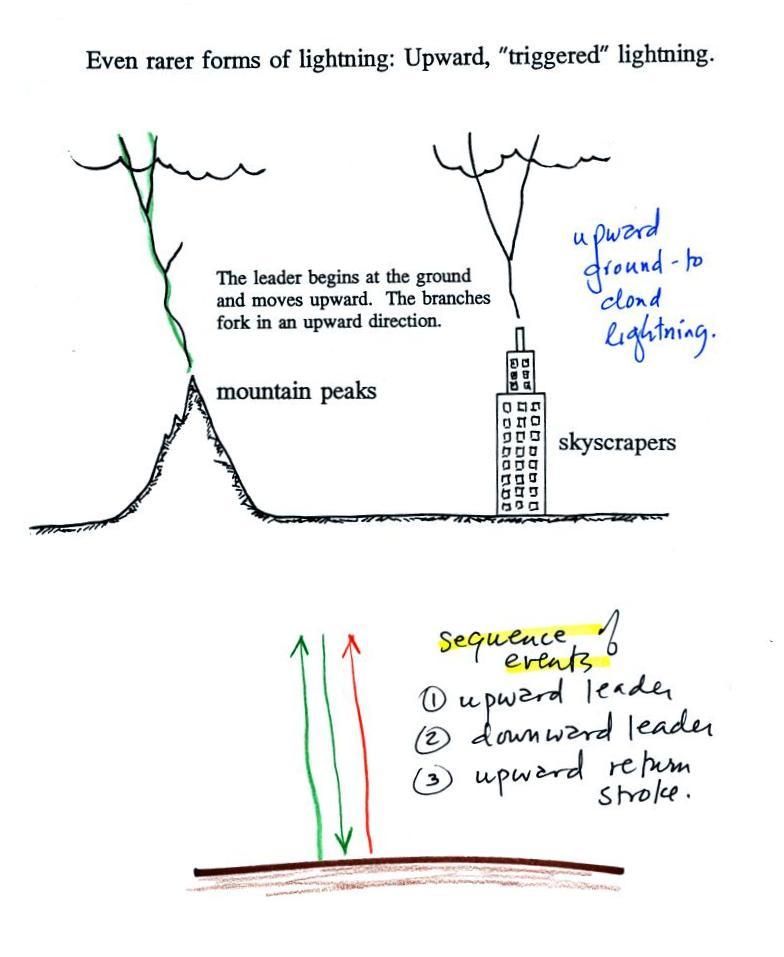 |
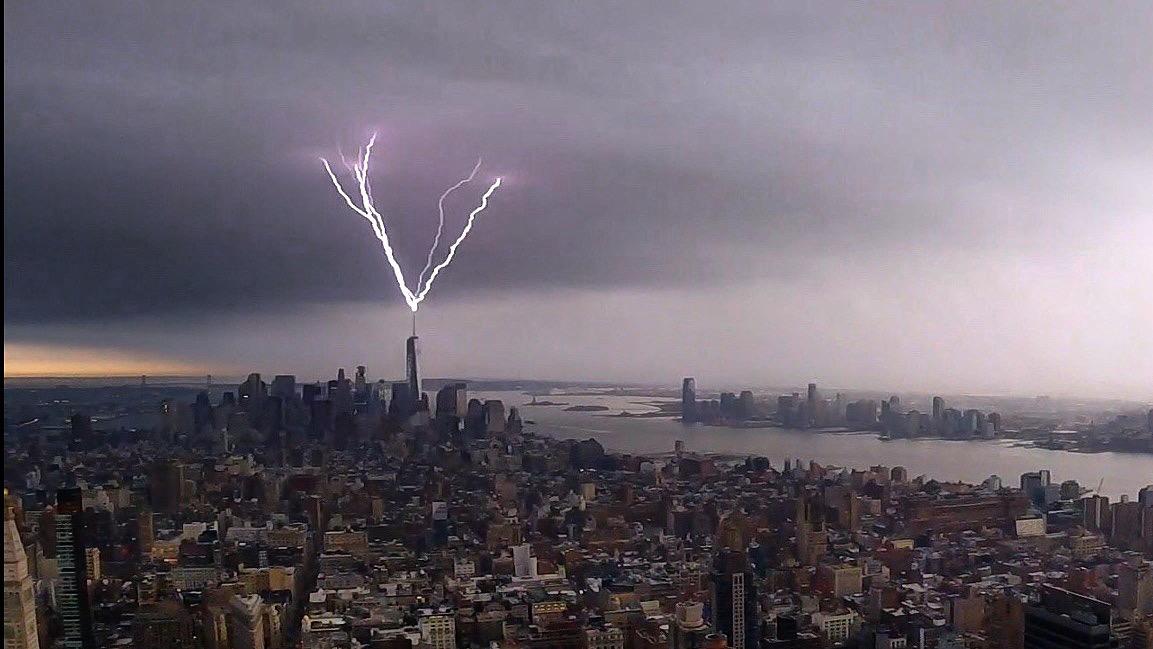
A very nice picture of an upward lightning initiated
by Freedom Tower in New York City. The photo was
taken from the Empire State Building (source of
this image).
|
Here's an even rarer form of lightning. Lightning
sometimes starts at the ground and travels upward. Upward
lightning is generally only initiated by mountains and tall
objects such as a skyscraper or a tower of some kind (the Empire
State Building is struck many times every year, it's usually
lightning that the building itself initiated; some very early
studies of lightning were carried out there).
Note the discharge is different in another way also.
These discharges are initiated by an upward leader. This is
not followed by a return stroke, like you might expect, but by a
more normal downward leader. Once the 2nd leader reaches the
ground, an upward return stroke travels back up the channel to the
cloud.
8. Rocket triggered lightning
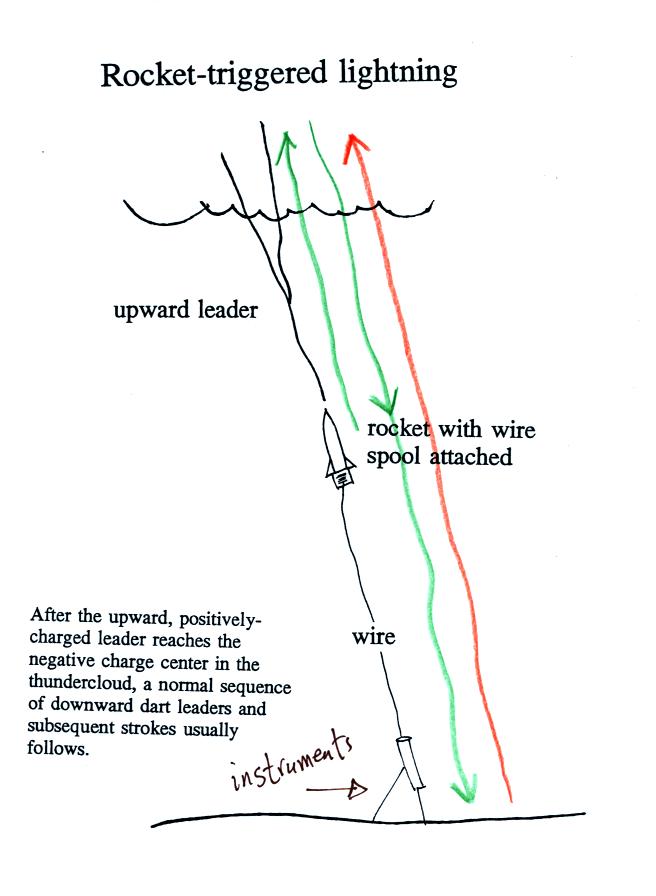
The fact that lightning could
begin with an upward discharge that begins at the ground led
(French) scientists to develop a technique to trigger lightning
by firing a small rocket up toward a thunderstorm. The
rocket is connected by a thin wire to the ground. When the
rocket gets 50 to 100 m above the ground an upward streamer will
develop off of the top of the wire. Once the streamer
reaches the cloud it can initiate a "normal" series of downward
dart leaders and upward subsequent return strokes.
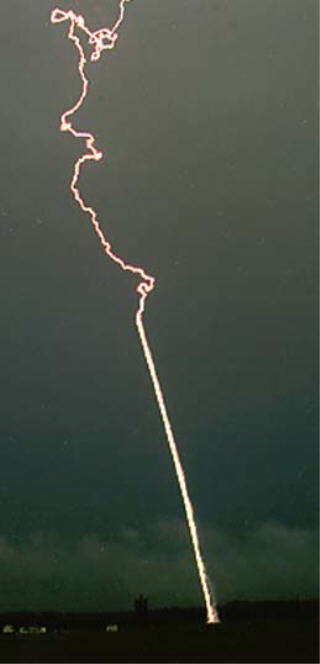
|
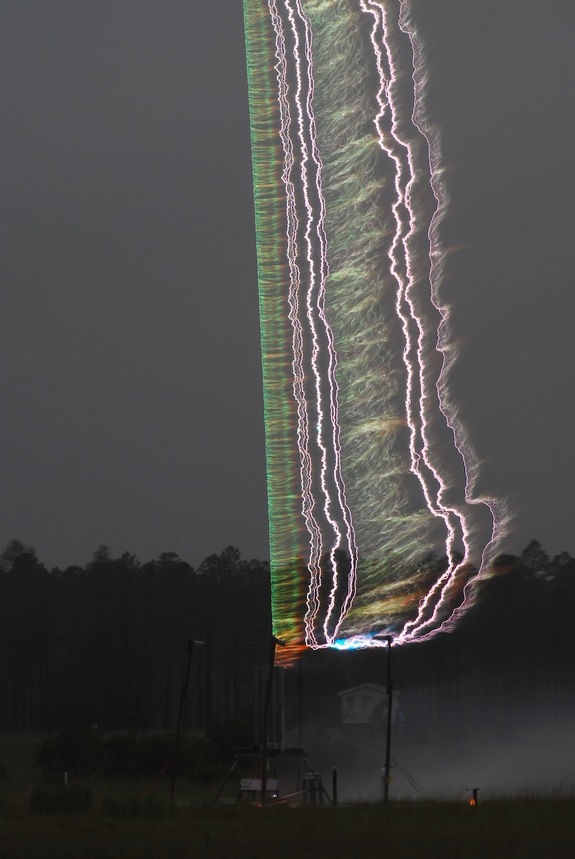
|
Photograph of a triggered lightning
discharge taken from a few 100 meters away. The
straight part of the channel is where the discharge
followed the wire. The lightning channel becomes
much more jagged when traveling through air above the
wire. (source of
this photo)
|
A closeup of triggered lightning
striking the launch tower. The green portion of
the image at left is produced by heating and
vaporization of the copper wire used to trigger the
discharge. The brighter whiter strokes of
lightning are seen at right. They have been spread
across the picture by wind. Photo credit: Doug
Jordan and Martin Uman International Center for
Lightning Research and Testing
|
Scientists are able to take closeup photographs and make
measurements of lightning currents using triggered
lightning. Triggered lightning can also be used to test the
operation of lightning protection devices.
Here's a link
to the video that was showed in class.
The abbreviation NLDN that you'll see at the start of the video
stands for National
Lightning Detection Network. The headquarters of this
company is located here in Tucson.
In the first 1:30 of the video you'll see natural lightning
occurring in the Tucson area during the summer (both intracloud
and cloud to ground discharges). Look for the
flickering that means multiple return strokes in a flash.
Between 1:30 and about 2:00 you'll see lightning activity
photographed at the Grand Canyon. Lightning at the Grand
Canyon preferentially strikes the edges of the canyon, a location
to avoid if you're there during a thunderstorm.
Next, between about 2:00 and 2:40 photographs of lightning
striking large wind turbines in Kansas. A lightning strike
to one of the turbine blades can cause damage that is very
expensive to repair. At 2:16 and again at about 2:24 you'll
see very bright lightning flashes that momentarily overexpose the
video. These were probably positive cloud to ground
discharges. And look carefully at the discharge that occurs
between about 2:28 and 2:31 on the video. Notice the upward
pointing branching. This was an upward discharge initiated
by one of the wind turbines.
Starting about 2:50 and for the remainder of the video you'll
see some rocket triggered lightning. These experiments were
done at the International Center for Lightning Research and
Testing (ICLRT) run by the University of Florida near Gainesville,
FL.
The green glow that you might have noticed in some of the
triggered lightning video probably comes from vaporization of the
copper wire that is carried upward by the rocket. If you're
someone that enjoys watching lightning storms you may remember
having seen a similar green glow when lightning strikes the
ground. I suspect this is caused by a strike to a
transformer on an electric power pole. The copper wire in
the transformer is vaporized by the lightning.
The vaporization of different chemical compounds is what gives
fireworks their distinctive colors. This
link lists some of the chemical compounds and the colors
they produce.
9. Fulgurites
When lightning strikes the ground it will often melt the soil
(especially sandy soil) and leave behind a rootlike structure
called a fulgurite. A fulgurite is just a narrow (1/2 to 1
inch across) segment of melted sand (glass). The photographs
of fulgurites above were found at the University of Florida
lightning triggering site.
10. Lightning safety
Lightning is a serious weather hazard. Here are some
lightning safety rules that you should keep in mind during
thundery weather.
Stay
away
from
tall
isolated
objects
during
a
lightning
storm.
You
can
be
hurt
or
killed
just
by
being
close
to
a
lightning
strike
even
if
you're
not
struck
directly.
Lightning currents often travel outward along
the surface of the ground (or in water) rather
than going straight down into the ground.
Just being close to something struck by
lightning puts you at risk. When
you hear of someone being struck by lightning
and living to tell about it, it was often a
nearby rather than a direct strike.
An
automobile with a metal roof and body provides good
protection from lightning. Many people think
this is because the tires insulate the car from the
ground. But the real reason cars are safe is
that the lightning current will travel through the
metal and around the passengers inside. The
rubber tires really don't play any role at
all. The people in Florida in the video that
were triggering lightning with rockets were inside a
metal trailer and were perfectly safe. All of
the connections made to equipment outside the
trailer were done using fiber optics, there were no
metal wires entering or leaving the trailer.
You shouldn't use a
corded phone or electrical appliances during a
lightning storm because lightning currents can follow
wires into your home. Cordless phones and cell
phones are safe. It is also a good idea to stay
away from plumbing as much as possible (don't take a
shower during a lightning storm, for example).
Vent pipes are connected to the plumbing and go up to
the roof of the house which puts them in a perfect
location to be struck by lightning.
To estimate the distance to
a lightning strike count the number of seconds between the
flash of light and when you first hear the thunder.
Divide this by 5 to get the distance in miles.
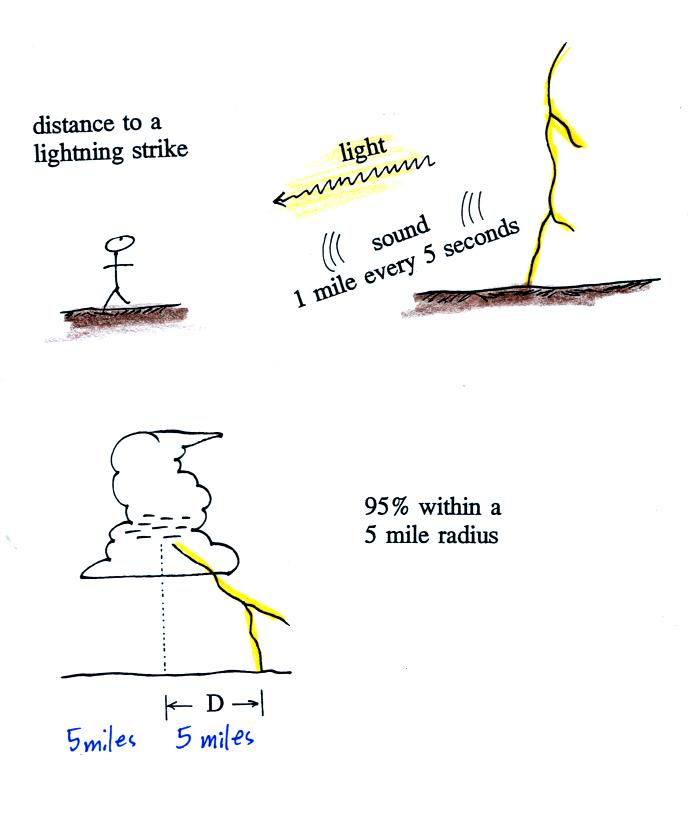
For example, a delay of 15 seconds between the flash of light
and the sound of thunder would mean the discharge was 3 miles
away. Research studies have shown that about 95% of cloud to
ground discharges strike the ground within 5 miles of a point
directly below the center of the storm. That's a 10 mile
diameter circle and covers the area of a medium size city.
The latest lightning safety recommendation is
the 30/30 Rule.
The 30/30 rule
People should seek shelter if the delay between a lightning
flash and its thunder is 30
seconds or less
(the lightning is within 6 miles).
People should remain under cover until 30 minutes after the final
clap of thunder. The powerful positive
strokes often occur at the ends of thunderstorms.
